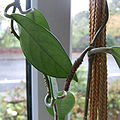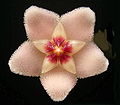Hoya (plant)
- For other uses, see Hoya (disambiguation) or Georgetown Hoyas.
| Hoya | |
|---|---|

| |
| Hoya bella | |
| Scientific classification | |
| Kingdom: | |
| Division: | |
| Class: | |
| Order: | |
| Family: | |
| Subfamily: | Asclepiadoideae
|
| Genus: | Hoya |
| Species | |
|
See text. | |
Hoya is a genus of 200-230 species of tropical climbing plants in the family Apocynaceae, native to southern Asia (India east to southern China and southward), Australia, and Polynesia. Common names for this genus are waxplant, waxvine, waxflower or simply hoya. This genus was named by botanist Robert Brown, in honour of his friend, botanist Thomas Hoy.
Summary
Hoyas are evergreen climbing vines or shrubs growing to 1-10 m (or more with suitable support in trees). They have simple opposite leaves 5-30 cm long that are typically succulent, and in many species are flecked with irregular small silvery spots.
The flowers appear in axillary umbellate clusters at the apex of 2-3 cm peduncles, with repeated clusters of flowers developing sequentially on each peduncle. The flowering peduncles get 2-3 mm longer with each flowering, and can eventually reach 7 cm or more long; the base of the peduncle is smooth, with growth subsequent to the first flowering of the peduncle is rough with numerous tiny bracts. Each flower is about 1 cm diameter, with five thick, waxy, triangular petals; colours range from white to pink or yellow. They are sweetly scented and produce abundant nectar.
Cultivation and uses
Many species of hoya are popular houseplants in temperate areas (especially H. carnosa), grown for their attractive foliage and strongly scented flowers. Numerous cultivars have been selected for garden use. Hoyas grow well indoors, preferring bright but not direct sunlight, but will tolerate fairly low light levels at the expense of rapid growth and blooming. Hoyas commonly sold in nurseries as houseplants include cultivars of H. carnosa (Krimson Queen, Hindu Rope − compacta), H. pubicalyx (often mislabeled as carnosa), and H. kerrii. Hoyas are easy to purchase on the internet, and are commonly sold as cuttings, either rooted or unrooted.
-
Hoya carnosa
as a houseplant -
Hoya carnosa
Inflorescence peduncle, several years old -
Hoya carnosa
Inflorescence -
Hoya carnosa
Single flower
Leaves
Hoya leaves vary in size, texture, color and venation. In size, leaves range from as small as centimetre in length and from two to four millimetres in width (Hoya engleriana, Hosseus) to as large as 25 cm. by 25 cm. (Hoya latifolia, G. Don). Hoya coriacea, Blume, has been reported have leaves as long as two feet in length. One of the most succulent, Hoya kerrii, Craib, has valentine shaped leaves, with notches at the apexes of the leaves instead of at the bases. H. Kerrii has two forms, one with glabrous leaves and one with suede textured leaves. There are hoyas with almost perfectly round leaves and others with linear leaves (Hoya linearis, Wall. ex. D. Don and Hoya teretifolia, Griff. ex Hook. f.). One popular species, Hoya shepherdii, Short ex Hook. has leaves that resemble string beans hanging in bunches from their stalks. Hoya linearis, Wall. ex D. Don is covered with fine downy hair and greatly resembles masses of Spanish Moss (Tillandsia useneoides) hanging from trees in its native habitat. Some Hoya leaves are smooth and shiny; some are covered with hairs. Some Hoya leaves appear to be veinless while others have very conspicuous veins of a lighter or darker colour than the rest of the leaves. Some have leaves that are mottled with speckles of silvery white (Hoya carnosa, R. Br., Hoya pubicalyx). Some hoyas have leaves that are thin and translucent (Hoya coriacea, Blume); some are so thick and succulent that they look more like crassulas than hoyas (Hoya australis subsp. rupicola, oramicola and saniae from Austrailia and Hoya pachyclada from Thailand).
Flowers
Hoya flowers are just as varied as the leaves, despite the fact that all are shaped like five pointed stars. They grow in umbels, usually with many flowers per umbel. Individual flowers range in size from as small as four to five millimetres in diameter (Hoya bilobata, Schltr.) to well over three inches in diameter (Hoya imperialis, Lindl. and H. macgillivrayi, F. M. Bailey). The number of flowers per umbel varies from one (H. pauciflora, Wight.) to 55 or even more. Hoya coriacea, Blume has been known to have as many as 70, each measuring nearly 2 centimetres in diameter. The single flowered Hoya pauciflora, Wight makes up for its paucity by its flower size of nearly an inch and a half in diameter.
Hoya flowers vary in textures as well as size, some being glabrous and shiny and some being quite hairy. They also vary in color. They come in the purest white, varying shades of pink from almost white to rubber-doll or bubble-gum pink, yellowish-pink, yellow, green, purple, brownish-red and brown. There are some that are so dark that they are often referred to as black. Until recently it was thought that a true red hoya was not ever likely to appear but recent discoveries make that seem possible. One of the two clones of Hoya mindorensis, Schltr., from the Philippines, which are currently in circulation, comes very close to being a true red. Blue still does not appear to be represented in the Hoya genus.
Selected species
|
|
|
Hoya Links
http://groups.msn.com/HoyasRUs http://members.tripod.com/khedlund/hoyapdl/ http://www.swedishhoyasociety.com/eng/hoya.htm




